| Lesson 5 | E-Commerce technology |
| Objective | Outline basic technologies associated with e-commerce. |
ecommerce Technology
In a post-Web 2.0 environment, several technologies play a pivotal role in shaping e-commerce transactions. Here is an outline of these key technologies:
These technologies are critical in facilitating e-commerce transactions in the modern digital landscape, driving efficiency, enhancing customer experiences, and enabling new business models.
- Application Programming Interfaces (APIs): APIs have become a cornerstone of e-commerce transactions, enabling various software applications to communicate and share data with each other. For example, APIs are used to connect e-commerce platforms with payment gateways, shipping services, customer relationship management (CRM) systems, and more. They support the seamless integration of various services, providing a comprehensive and efficient e-commerce ecosystem.
- Mobile Technologies: With the advent of smartphones, mobile technologies have reshaped the e-commerce landscape. Mobile applications and responsive web design are critical for reaching customers who prefer shopping via their mobile devices. Additionally, technologies such as Near Field Communication (NFC) and QR codes enable mobile payments, enhancing the ease and convenience of transactions.
- Cloud Computing: Cloud computing has become an integral part of e-commerce, providing scalable and flexible resources for data storage, processing, and analytics. It supports the hosting of e-commerce platforms, handles high volumes of transactions, and enables real-time inventory management. Cloud services also facilitate data analysis for personalized marketing and customer insights.
- Artificial Intelligence (AI) and Machine Learning (ML): AI and ML are transforming e-commerce by enabling personalized customer experiences, efficient operations, and strategic decision making. They are used in chatbots for customer service, recommendation engines for personalized product suggestions, predictive analytics for forecasting demand, and automation of various operational tasks.
- Blockchain and Cryptocurrencies: Blockchain technology is gradually being integrated into e-commerce, enhancing transparency, security, and trust in transactions. Smart contracts automate transactions based on pre-set rules, reducing the need for intermediaries. Cryptocurrencies like Bitcoin are also being accepted as a mode of payment by some e-commerce platforms, reflecting a shift towards decentralized digital currencies.
- Cybersecurity Technologies: With the increasing prevalence of e-commerce transactions, the importance of cybersecurity has amplified. Technologies like Secure Sockets Layer (SSL) encryption, two-factor authentication (2FA), and intrusion detection systems (IDS) are essential for protecting sensitive data, preventing fraud, and building customer trust.
- Big Data and Analytics: E-commerce businesses rely heavily on big data and analytics to understand customer behavior, optimize marketing campaigns, and make informed business decisions. Data analytics tools allow businesses to gain actionable insights from large volumes of transactional data, improving customer satisfaction and business performance.
- Internet of Things (IoT): IoT technology can enhance e-commerce transactions, particularly in areas like logistics and supply chain management. IoT devices can track inventory in real-time, monitor the condition of goods in transit, and enable seamless, automated purchasing of products or services when needed.
These technologies are critical in facilitating e-commerce transactions in the modern digital landscape, driving efficiency, enhancing customer experiences, and enabling new business models.
Ecommerce technologies, particularly for web-based e-commerce, involve a wide range of telecommunications, software, and hardware that together form a complete e-commerce solution.
These are also the basic elements that differentiate e-commerce from traditional commerce. Let's look at these in more detail.
Telecommunications and Hardware
Telecommunications acts as the information pipe, connecting buyers and sellers. Hardware provides the physical plant to execute software and to integrate software to telecommunications.
Software
Software provides the long list of functions typically associated with e-commerce, including:
As mentioned above, telecommunications, hardware, and software are the basic elements that differentiate e-commerce from traditional commerce. The Slide Show below describes these elements in more detail.
- Creating and displaying the Web-based storefront or catalog
- Handling payments and interfacing with payment service providers
- Capturing site traffic information to support marketing activities
- Implementing security (often in conjunction with certain telecommunications protocols)
- Integrating e-commerce solutions with other enterprise software applications
- Providing transaction processing capabilities to handle orders throughout fulfillment and shipping
As mentioned above, telecommunications, hardware, and software are the basic elements that differentiate e-commerce from traditional commerce. The Slide Show below describes these elements in more detail.
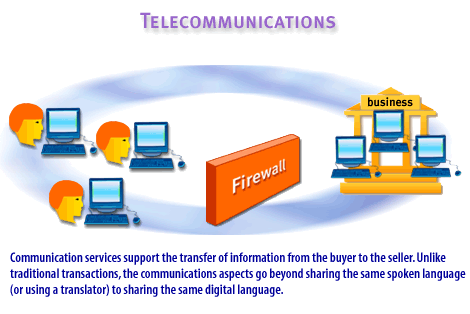
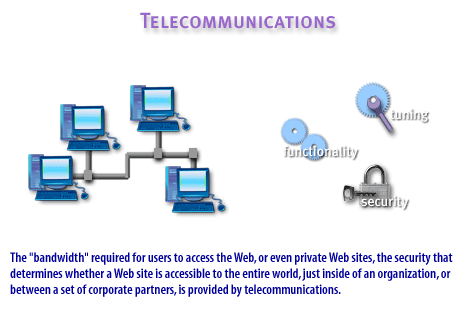
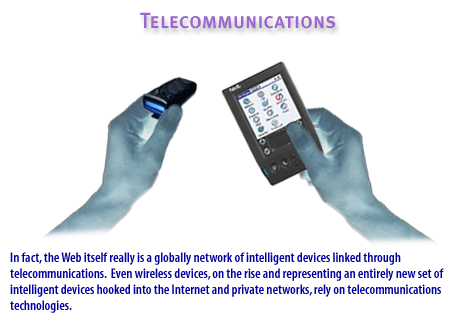
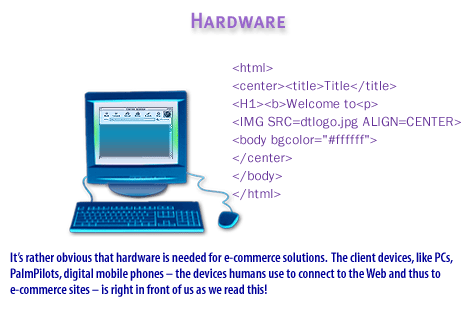
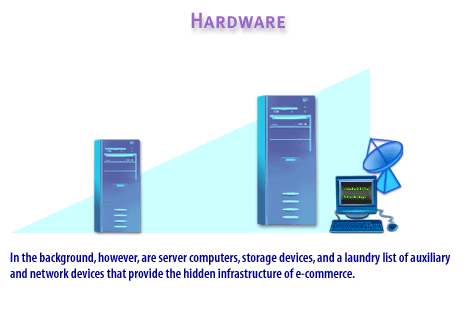
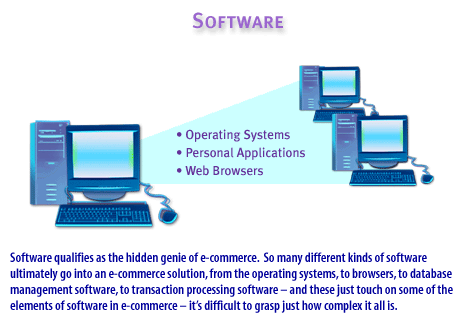
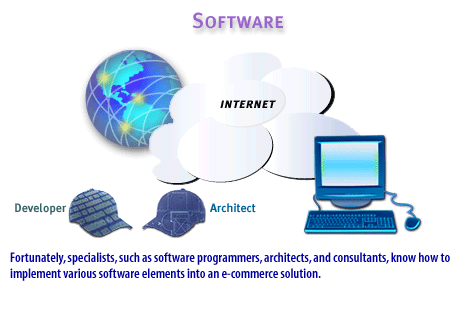
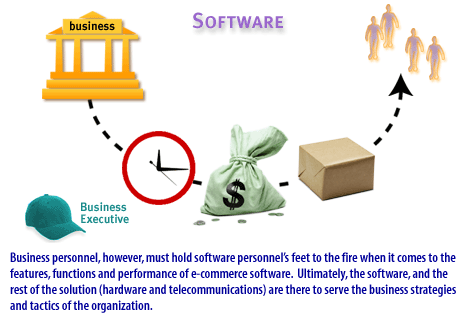
Elements differentiating Ecommerce
In the next lesson, we will identify some of the potential challenges associated with e-commerce, and discuss strategies for overcoming some of these problems.
In the next lesson, we will identify some of the potential challenges associated with e-commerce, and discuss strategies for overcoming some of these problems.
The historical development of e-commerce suggests that it emerged as a powerful force only after a truly open and standard data network known as
the Internet was coupled with easy-to-use software, primarily the invention of Netscape. Many innovative business models evolved in an attempt to take advantage of this new platform, coupled with a host of clever new marketing strategies. Ecommerce opened up new avenues for consumers as well, creating new consumer-centric markets in which their bargaining power has been enhanced. New methods of payment (such as Paypal) as well as approaches to improving the security of online transactions were introduced. Despite these developments, a key theme of the chapter is that although much has changed as a result of e-commerce, many of the expected impacts have not occurred. A review of research on several anticipated impacts highlights the need to critically assess the early hype regarding the effect of e-commerce on competitive strategy, market structures, B2B relationships, and prices of goods and services.